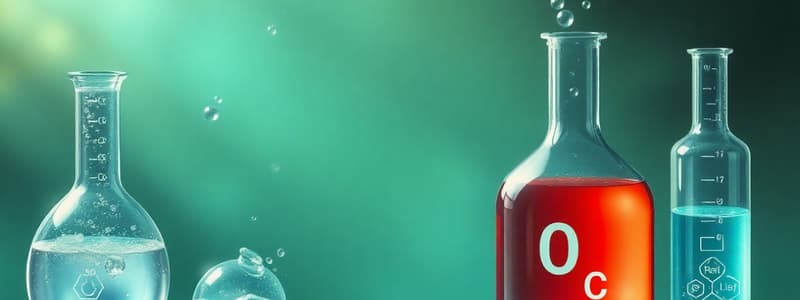Podcast
Questions and Answers
What is the definition of Actual Yield in a chemical reaction?
What is the definition of Actual Yield in a chemical reaction?
- The theoretical amount of product expected from a reaction
- The combined mass of all reactants used in the reaction
- The mass of product actually formed in a chemical reaction (correct)
- The maximum possible yield of reactants
Which of the following statements correctly describes a Limiting Reagent?
Which of the following statements correctly describes a Limiting Reagent?
- It represents the total mass of reactants available.
- It is the substance that determines the maximum amount of product formed. (correct)
- It is irrelevant to the chemical reaction taking place.
- It is the reactant that is present in excess during the reaction.
What is Avogadro's Number?
What is Avogadro's Number?
- 6.023 x 10^22
- 1 mole of a substance expressed in grams
- The weight of a single molecule in atomic mass units
- 6.023 x 10^23 (correct)
Which process eliminates color in compounds through the use of chemicals?
Which process eliminates color in compounds through the use of chemicals?
What does a Net Ionic Equation represent?
What does a Net Ionic Equation represent?
What term describes a chemical reaction that absorbs heat?
What term describes a chemical reaction that absorbs heat?
Which term refers to the process when ionic compounds separate into positive and negative ions in water?
Which term refers to the process when ionic compounds separate into positive and negative ions in water?
What is indicated by the term Molar Mass in chemistry?
What is indicated by the term Molar Mass in chemistry?
In a combustion reaction, what is the primary physical change that occurs?
In a combustion reaction, what is the primary physical change that occurs?
Which of the following accurately defines Formula Weight (FW)?
Which of the following accurately defines Formula Weight (FW)?
Flashcards are hidden until you start studying
Study Notes
Actual Yield
- The amount of product you get from a chemical reaction.
- Measured in mass, the actual amount of product formed or isolated.
Aqueous Solutions
- Solutions where water acts as the solvent.
Avogadro's Number
- Represents the number of atoms in 1 mole of any compound.
- The value is 6.023 x 10^23.
Batteries
- A type of voltaic cell.
- Produce electricity through chemical reactions.
Bleaching
- A process that decolorizes compounds.
- Achieved by the presence of bleaches.
Chemical Equation
- Uses chemical formulas to represent the transformation of reactants to products.
Combustion
- The process of burning in air.
Dissociation
- When ionic compounds dissolve in water, the positive and negative ions separate.
Endothermic
- A chemical reaction that absorbs heat from its surroundings.
Exothermic
- A chemical reaction that releases heat to its surroundings.
Formula Weight (FW)
- The sum of the atomic weights of all the atoms in a chemical formula.
- Expressed in atomic mass units (amu).
Heat of Combustion
- The heat released during a combustion reaction.
Heat of Reaction
- The heat change (released or absorbed) that occurs during a chemical reaction.
Limiting Reagent
- The reactant that gets completely consumed first in a chemical reaction.
- Determines the amount of product formed.
Molar Mass
- The mass of one mole of a substance expressed in grams.
- Equivalent to the formula weight expressed in grams.
Mole (mol)
- The formula weight of a substance expressed in grams.
- A unit of measurement commonly used in chemistry.
Molecular Weight (MW)
- The weight of a molecule.
- The sum of the atomic weights of all atoms in a molecular compound, expressed in amu.
Net Ionic Equation
- A chemical equation that excludes spectator ions (ions that remain unchanged).
- Represents the actual chemical change occurring in a reaction.
- Both atoms and charges are balanced.
Actual Yield
- The amount of product you get from a chemical reaction.
- Measured in grams.
Aqueous Solutions
- Solutions where water is the solvent.
Avogadro's Number
- The number of atoms in one mole of any compound.
- 6.023 x 10^23.
Batteries
- A type of voltaic cell.
- Generate electricity through a chemical reaction.
Bleaching
- The process of making colored compounds colorless.
- Occurs in the presence of bleaches.
Chemical Equation
- A representation of chemical reactions using chemical formulas.
- Shows reactants converting to products.
Combustion
- Burning in the presence of air.
Dissociation
- Occurs when ionic compounds dissolve in water.
- Positive and negative ions separate.
Endothermic Reactions
- Chemical reactions that absorb heat from surroundings.
Exothermic Reactions
- Chemical reactions that release heat to surroundings.
Formula Weight (FW)
- The total atomic weights of all atoms in a chemical formula.
- Measured in atomic mass units (amu).
Heat of Combustion
- The amount of heat released during a combustion reaction.
Heat of Reaction
- The amount of heat released or absorbed during a chemical reaction.
Limiting Reagent
- The reactant that runs out first in a chemical reaction.
- Limits the amount of product formed.
Molar Mass
- The mass of one mole of a substance in grams.
- The formula weight in grams.
Mole (mol)
- The formula weight of a substance expressed in grams.
Molecular Weight (MW)
- The weight of a molecule.
- Sum of the atomic weights of all atoms in a molecular compound.
- Measured in atomic mass units (amu).
Net Ionic Equation
- A chemical equation that does not include spectator ions.
- Both atoms and charges are balanced.
Studying That Suits You
Use AI to generate personalized quizzes and flashcards to suit your learning preferences.




